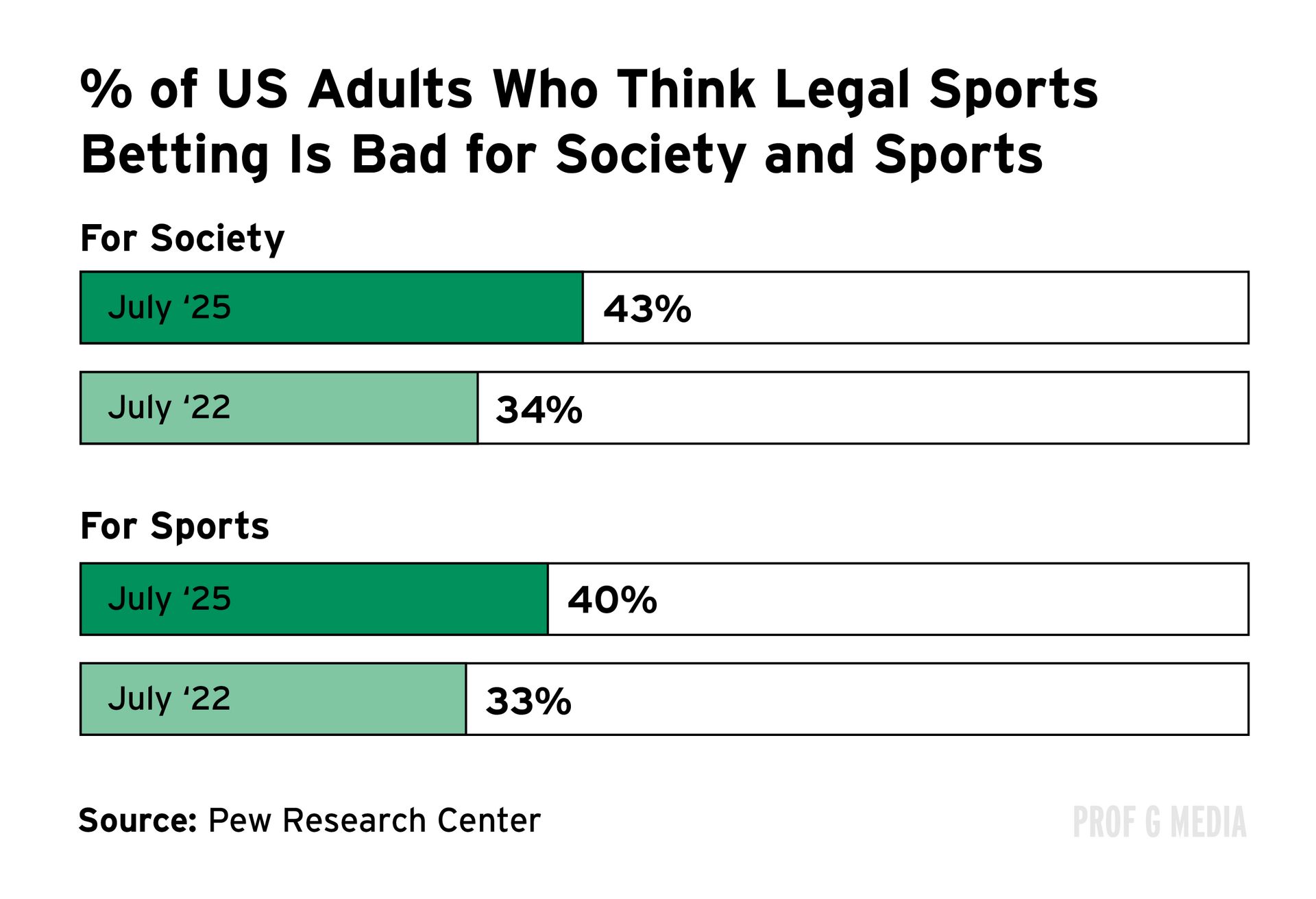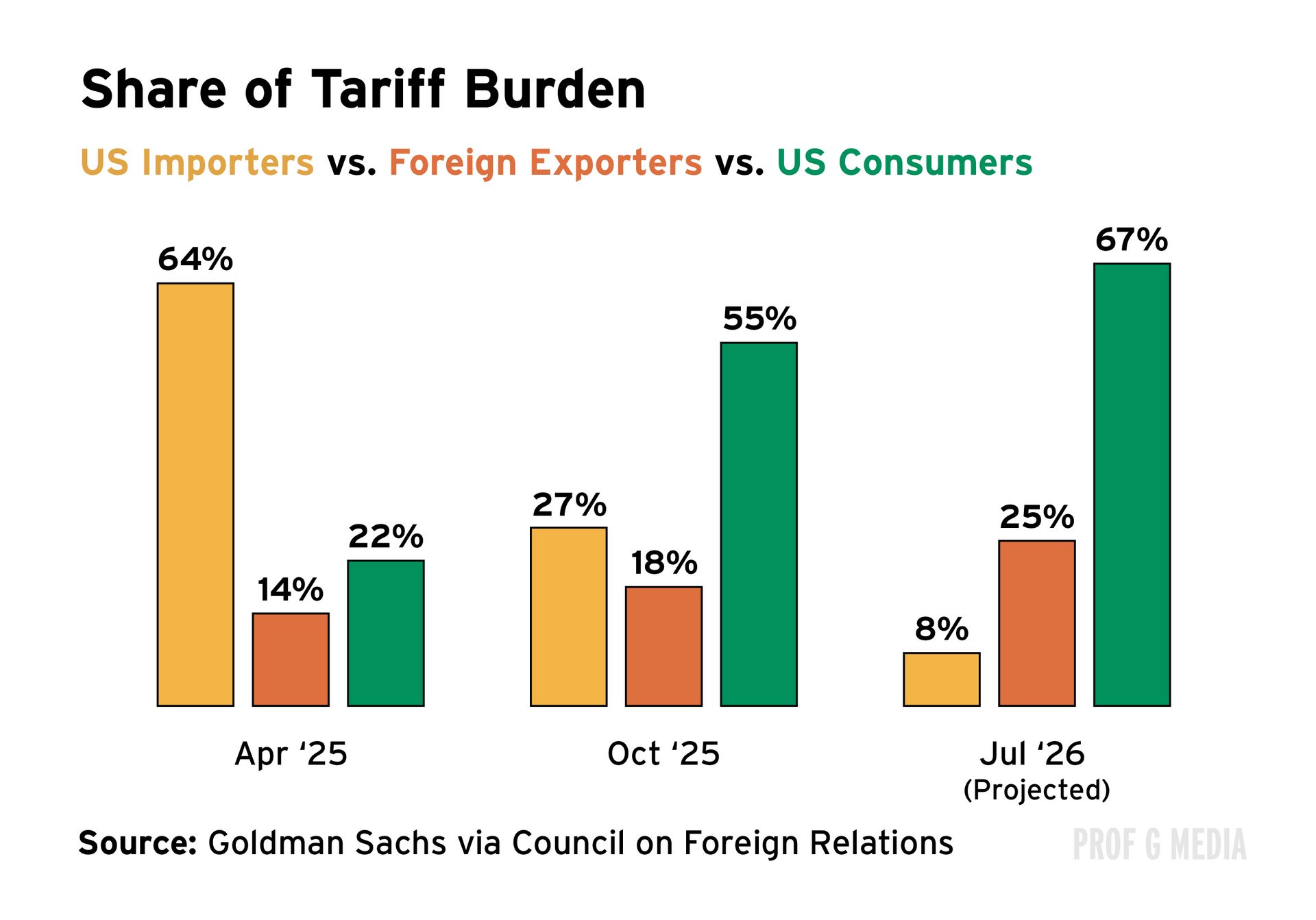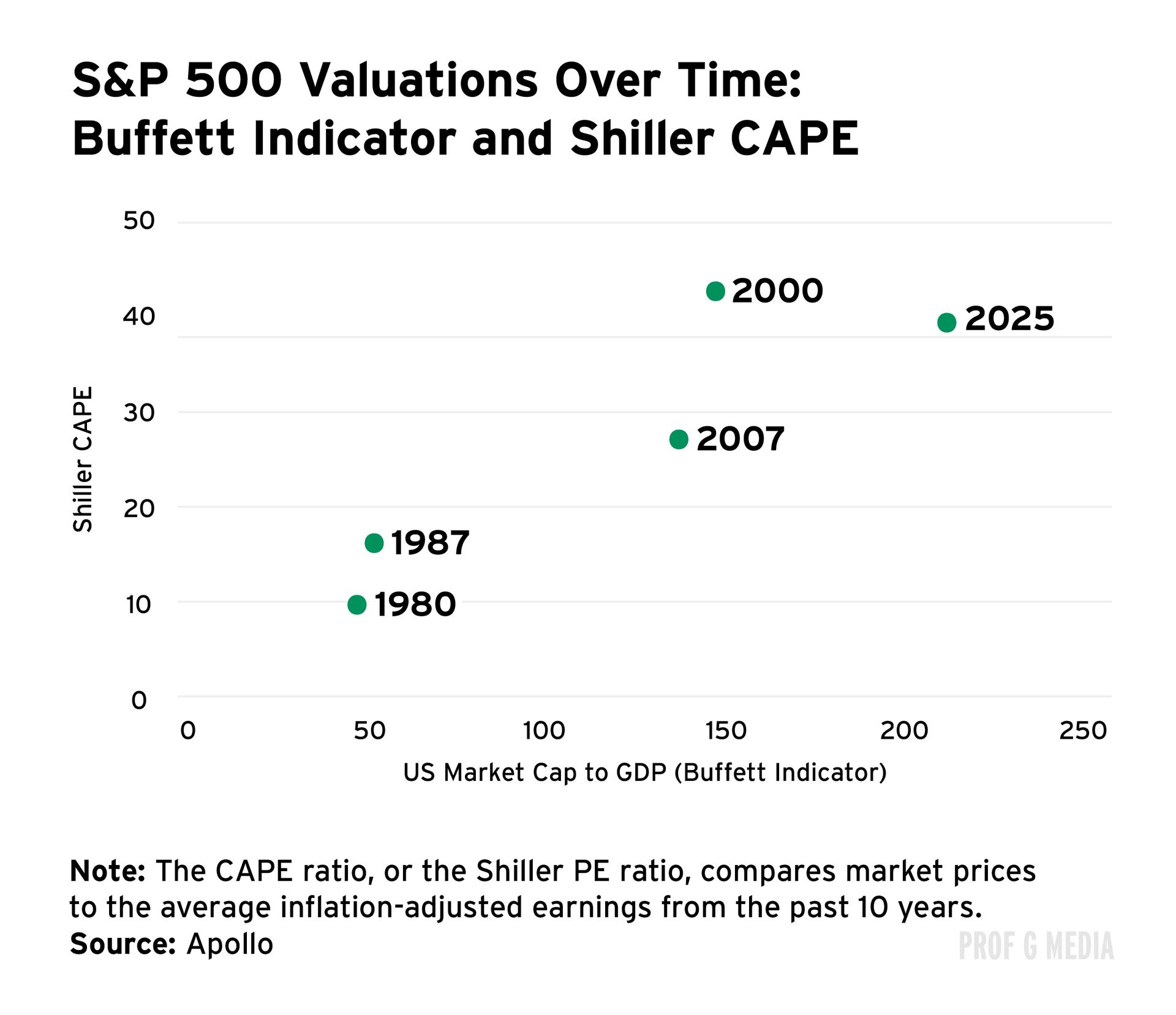In partnership with


75%
People are 75% more likely to get divorced if a close friend is divorced.

The business of betting: Robinhood and the rise of prediction markets
Trump’s tariffs face the Supreme Court
A week of red flags at OpenAI
Newsletter Exclusive: Hunting for AI’s underrated winners
Robinhood’s Revenue Doubles, Prediction Markets Break Volume Records
Robinhood posted earnings that topped expectations after doubling revenue year over year. The stock is one of the best performers in the S&P 500 this year, soaring 450% since Trump’s election.
A key driver of that momentum is prediction markets. In March, Robinhood integrated Kalshi into its app, and is now reportedly seeking acquisitions to increase its exposure to the industry. Event contracts traded on Robinhood more than doubled quarter over quarter to 2.3 billion, as election speculation pushed volumes to all-time highs.
Simply put, prediction markets are on fire.
Kalshi and Polymarket hit record trading volumes in the past month.
Trump Media & Technology Group, Donald Trump’s media company, is reportedly launching a crypto-based prediction market.
Last week, Google announced plans to integrate Kalshi and Polymarket data directly into search results for questions about future events.
Proponents of prediction markets claim that trading on future events isn’t gambling. Last November, Kalshi’s lawyers argued that it is a “federally regulated exchange” and that gambling laws applied only to games or game-related events. A few months later, the company started letting users bet on the Super Bowl.
Since football season began, sports wagers have accounted for over 90% of Kalshi’s trading activity.
Dustin Gouker noted in his Event Horizon newsletter that Kalshi has even run social media ads promoting sports betting.

Kalshi doesn’t have much to fear from federal regulators. Trump and his inner circle have deep ties to prediction markets. Trump’s first pick to lead the Commodity Futures Trading Commission (CFTC), which oversees derivatives markets, was a Kalshi board member. His next nominee is a lawyer for a firm that has represented Kalshi, arguing it was “arbitrary and capricious” to ban sports event contracts. Donald Trump Jr. advises both Kalshi and Polymarket, and invests in the latter. Susquehanna International Group, the trading firm co-founded by billionaire Jeff Yass and a major Trump donor, is one of Kalshi’s primary market makers.
Trump’s familiarity with gambling goes back decades, but his record isn’t exactly encouraging. Starting in the 1980s, his Atlantic City casinos lost more money and jobs than their competitors and filed for bankruptcy four times.

We’ve rebranded gambling as “prediction markets.” Sounds smarter to bet on the Fed than the Jets, right? But let’s be honest. It’s still gambling.
And it’s dangerous. Gambling in households increases the odds of domestic violence by over 10x, and gambling has the highest suicide rate of any addiction — roughly 1 in 5 people with a gambling addiction attempt suicide. Yet, gambling addiction receives almost no federal funding. Why? There’s too much money in it.
Legalization makes it worse. In states with legal sports betting, personal bankruptcies jump 28%. It disproportionately affects low-income families, men, and, increasingly, young people. Ninety percent of high school students surveyed in New York said they’d gambled at least once in the past year.
Supporters claim that legalizing raises tax revenue. But for every one dollar collected, states lose over four in net costs.
Bottom line: We’ve monetized the White House, and we’re now monetizing people’s addictions and the immature prefrontal cortices of the male population.


Gambling has always existed. The difference now is access. You do not need to walk into a casino. You just pick up your phone.
The regulatory environment has also changed. Now the government is behind it, and there is a very obvious support system for gambling.The big question for U.S. citizens is “Do we want this?”
Supreme Court Questions Trump’s Tariff Powers
Last week, the Supreme Court heard arguments in Learning Resources, Inc. v. Trump, the case regarding the president’s authority to impose tariffs using the International Emergency Economic Powers Act (IEEPA). The plaintiffs are two educational toy manufacturers, and hundreds of small businesses joined court filings that call the tariffs unlawful.
Arguments didn’t go particularly well for the Trump administration. By the end of the week, markets were pricing just a 25% chance of the court ruling in his favor—down from 48% before the hearing.
What is IEEPA?
It’s a law passed in 1977 that grants the president broad economic powers following the declaration of a national emergency. Presidents have used IEEPA to impose economic sanctions on other nations and to target terrorists. No other president has used the law to impose tariffs.
Both conservative and liberal justices questioned the Trump administration’s assertion that it has the power to unilaterally impose tariffs without congressional approval.
Helpful context:
Article 1, Section 8 of the Constitution gives Congress the “Power To lay and collect Taxes, Duties, Imposts and Excises” and “regulate Commerce with foreign Nations.”
Here were some of the justices’ arguments:
“Is it your contention that every country needed to be tariffed because of threats to the defense and industrial base? I mean, Spain? France? I could see it with some countries, but explain to me why as many countries needed to be subject to the reciprocal tariff policy as are.”
- President Trump nominee Justice Amy Coney Barrett
“The vehicle [tariffs] is the imposition of taxes on Americans, and that has always been the core power of Congress.”
- President George W. Bush nominee Chief Justice John Roberts
“Congress, as a practical matter, can’t get this power [tariff authority] back once it’s handed it over to the president. … It’s a one-way ratchet toward the gradual-but-continual accretion of power in the executive branch and away from the people’s elected representatives … What would prohibit Congress from just abdicating all responsibility to regulate foreign commerce — for that matter, declare war — to the president?”
- President Trump nominee Chief Justice Neil Gorsuch
So, what happens if the tariffs are unconstitutional?
The Trump administration will likely have to issue $195 billion in refunds to the businesses that have been hurt by tariffs. That process could take months or years — or might never happen.
Even if the court rules that Trump’s use of IEEPA to enact tariffs was unlawful, legal experts have warned that there are a number of alternative statutes he could use to push them through. The legal battle will likely continue.


Right now, private capital is arbitraging regulatory uncertainty, and I’m trying to get in on the investment. Importing companies that have paid Trump tariffs are selling the rights to potential refunds to private investors. Hedge funds are paying roughly 20–40 cents for each dollar they might eventually get back if the court overturns the tariffs.
If the Supreme Court sides with the importers, investors get the full refund, turning a few cents into a dollar for each claim.
But, there’s still a question of whether the government will actually have to pay the refunds. We’ve seen Trump refuse to pay on a number of occasions. I’ve decided that there’s about a 1 in 10 chance that this claim will be refunded, and I like the asymmetric upside. So, I’m buying claims.
____________sponsored content ____________
Keep Your SSN Off The Dark Web
Every day, data brokers profit from your sensitive info—phone number, DOB, SSN—selling it to the highest bidder. What happens then? Best case: companies target you with ads. Worst case: scammers and identity thieves breach those brokers, leaving your data vulnerable or on the dark web. It's time you check out Incogni. It scrubs your personal data from the web, confronting the world’s data brokers on your behalf. And unlike other services, Incogni helps remove your sensitive information from all broker types, including those tricky People Search Sites.
Help protect yourself from identity theft, spam calls, and health insurers raising your rates. Plus, just for you: Get 55% off Incogni using code PROFG.
____________sponsored content ____________
Red Flags at OpenAI: Old Drama Resurfaces, New Challenges Emerge
It was a week of red flags for OpenAI. First, the recently released deposition of OpenAI’s co-founder, Ilya Sutskever, shed new light on his time at the company and the drama around OpenAI CEO Sam Altman’s firing. (That drama is the subject of a movie that’s currently in production, with Andrew Garfield as Sam Altman). In the deposition, Sutskever referenced a memo stating that Altman was fired due to a loss of confidence and alleging a “consistent pattern of lying.”
It’s not the first time Altman has faced questions about his behavior. He was pushed out of Y Combinator after similar allegations of manipulation; employees at his first startup, Loopt, reportedly urged the board to fire him “over deceptive and chaotic behavior”; and his sister has accused him of sexual abuse.
The company’s CFO, Sarah Friar, added to the PR pileup at The Wall Street Journal's Tech Live event, telling reporters that the market “isn’t exuberant enough” about AI — a bold take in 2025. Friar also said OpenAI was seeking a federal “backstop” to help finance future data centers and guarantee loans. After the comment went viral, she clarified on LinkedIn that OpenAI isn’t seeking government support.
Then Altman expanded upon OpenAI’s position in a 900-word tweet. He wrote that OpenAI does not want government guarantees for data centers and outlined a vague plan for how OpenAI will fund its ambitions (including expanding into AI cloud services, new enterprise tools, and hardware categories like consumer devices and robotics).

Eighty percent of a company's valuation used to be based on earnings and industry fundamentals. Then Jeff Bezos changed everything with his seminal 1997 letter to investors — it just made you want to buy Amazon stock.
Now, a CEO’s ability to tell a story and raise extraordinary amounts of capital has become the core competence. Netflix adopted that strategy. So did Palantir’s Alex Karp. Adam Neumann tried.
That’s what Sam is doing: engaging in this capital war by signaling he’s going to build 50 nuclear power plants and spend almost $1.5 trillion on compute because he has insight into the numbers and the business like no one else.
I wonder how many of these big announcements are just Sam trying to manifest success. Take the $300 billion agreement with Oracle. I’d love to see the actual terms and conditions of that contract because I wouldn’t be surprised if it’s more like Trump’s favorite word: a framework.
All of these jazz hands are signaling that OpenAI is headed toward an IPO. I think it will happen sometime in 2026, because the valuation based on revenue multiples is getting to the point where no institutional investor will want to buy more.

In response to a question about how OpenAI will finance its massive commitments, Sam Altman told Brad Gerstner “enough” and shortly thereafter ended the interview. I couldn’t think of a more defensive response.
Sam Altman is the high priest of AI, and AI is what’s holding the stock market and the economy together. Maybe his fumbled answer is a tell that he doesn’t know how he’s going to pay for all of OpenAI’s compute deals, and that could be the beginning of the end.
It’s important to recognize the way these things happen. It’s not like there’s a sequence of bad earnings calls and then suddenly everyone realizes that this AI boom isn’t what we thought it was.
There needs to be some narrative shock to the system. You need to have some spectacular story that hits people all at once, causes a massive shift sentiment, and starts a chain reaction.
That’s how this always goes down. Take FTX. Sam Bankman-Fried was crypto’s figurehead at the time, and his very public fall from grace led to the bankruptcy of over 100 firms and a huge drawdown in the crypto sector.
For the bubble to pop in AI, you’re gonna need a story. You’re gonna need something that is spectacular, that captures the imaginations of the investment community. If you had to bet on a story happening, it is the implosion of OpenAI.
Newsletter Exclusive: The Company Everyone’s Using, But No One’s Noticing
Last week, Goldman Sachs and Morgan Stanley warned that markets could be due for a 10%–20% correction. Tech stocks fell on the news, putting the Nasdaq 100 on track for its worst week since April.
Market valuations, particularly in tech, have stretched well beyond historical averages. The forward price-to-earnings ratio of the Nasdaq 100 is now nearly 28, above an average of 23 over the past decade, and a Bank of America survey found that 54% of fund managers believe AI stocks are in a bubble.
The Magnificent Seven have fueled most of the market’s gains and now make up 37% of the S&P 500. So where can investors still find value? Or, put differently: Who are the Modest Seven?

One contender is MediaTek, a Taiwanese semiconductor company that, like Qualcomm, Nvidia, and AMD, designs chips but outsources its manufacturing.
Despite powering more smartphones globally than any other chipmaker and having exposure to AI, electric vehicles, and satellite communications, plus partnerships with Nvidia, Google, Apple, Meta, BYD, and Airbus, MediaTek still trades at just 3.6x sales, roughly in line with its five-year average.
MediaTek sits at the crossroads of three major tech shifts: China’s move away from U.S. tech, the expansion of satellite communication, and the rise of custom-built AI chips. Despite this, the stock is down 2% over the past year.
China’s Shift Away From U.S. Tech
MediaTek is positioned to benefit from the demographic expansion of non-U.S. smartphone markets and China’s push to reduce reliance on American companies.
The company now holds a dominant position in global smartphone chips outside the iPhone ecosystem. In Q1 2025, it led worldwide shipments with a 36% share of smartphone chip units, outpacing Qualcomm (28%) and Apple (17%).
Its flagship chips now power over 40% of China’s high-end Android phones; it has a 51% share of India’s 5G market and a 40% share of the Latin American smartphone market.
The Next Frontier
MediaTek is also becoming a major player in satellite communications. In Europe and Asia, it’s one of the leading suppliers of chips that let smartphones and connected devices link directly to satellites. The company has partnered with Airbus, Eutelsat, Inmarsat, and Bullitt Group to develop and test these systems, and has already demonstrated 5G satellite connections using OneWeb’s low-Earth-orbit network.
The Era of Custom Chips
As companies seek cheaper, more specialized alternatives to Nvidia’s GPUs, MediaTek is emerging as one of the most popular custom chip partners for Big Tech.
It’s working with Google on TPUs, Meta on AR glasses and a custom AI chip, Apple on 5G modems and Apple Watch components, BYD on AI-powered cockpit systems, and Nvidia on hardware for its AI supercomputers.
The custom chip market is among the fastest-growing segments in semiconductors. MediaTek expects the sector to exceed $50 billion by 2028 and is targeting a 10%–15% share — a meaningful expansion for a company with $18 billion in annual revenue.
As Scott predicted last year, the big growth story of 2025 isn’t just AI — it’s emerging markets. As international economies expand, the most important companies won’t all have headquarters in Silicon Valley. MediaTek is a reminder of that.*
(*Not investment advice).

Scott’s latest book, Notes on Being a Man, is currently the No. 1 bestseller on Amazon. Buy it here to support independent bookstores.

The investment market for claims against Trump’s tariffs will become increasingly active.

From political speeches to songs, how would Americans react if they found out AI was involved?
Reasons to be optimistic about the economy
Enjoy these idioms from different languages
